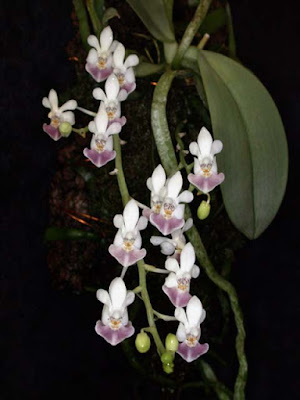Phalaenopsis parishii is native to Eastern Himalaya, Assam in India, Moulmein in Myanmar, Thailand and Vietnam. Plants meet on moss-covered branches of trees hanging over streams at lower elevations to 500 meters, where hot and humid weather prevails during the growing season.
Phalaenopsis parishii orchid, also called as Parish's Phalaenopsis (named after the English orchid collector Parish), Aerides decumbens, Kingiella decumbens, Biermannia decumbens, Phalaenopsis decumbens, Kingidium decumbens, Polychilos decumbens, Doritis parishii, Grafia parishii, Polychilos parishii, is a species of the genus Phalaenopsis. This species was described by Heinrich Gustav Reichenbach in 1865.
IDENTIFY PHALAENOPSIS PARISHII ORCHID
Phalaenopsis parishii is native to Eastern Himalaya, Assam in India, Moulmein in Myanmar, Thailand and Vietnam. Plants meet on moss-covered branches of trees hanging over streams at lower elevations to 500 meters, where hot and humid weather prevails during the growing season.
It is a miniature sized, hot to warm growing epiphyte with elliptic to obovate, fleshy, pendant, leaves. The leaves are 5-15 cm long. If the hydration level is not adequate, they may become leathery or they may fall.
Parish's Phalaenopsis blooms on an arching, 2 to 4 3/4" (5 to 14 cm) long, lightly fractiflex, racemose or rarely paniculate, few to several, densly flowered inflorescence with small floral bracts and carrying 5 to 6, lily of the valley scented, simultaneously opening flowers occurring in the spring. The small flowers are 2 cm in diameter and are large in relation to the whole plant. They have a star shape, and the petals of the outer whorl tend to curl. The petals of both whorls may be white or yellow. The lip has purple to crimson spots and four filamentous protuberances growing from its apex. The side plots are yellow with purple spots.
GROW AND CARE PHALAENOPSIS PARISHII ORCHID
Cultural information should only be used as a guide, and should be to be adapted to suit you. Your physical location; where you grow your plants, how much time you have to devote to their care, and many other factors, will need to be taken into account. Only then can you decide on the cultural methods that best suit you and your plants.
Light:
Phalaenopsis parishii needs a light level of 15,000 lux. Plants in cultivation prefer scattered light rather than deep shadow.
Temperature:
The average summer temperature is 28-32 ° C, night 24 ° C, giving a daily difference of 4-7 ° C. In winter, the average day temperature is 31-35 ° C, and at 19-23 ° C at night, giving a daily difference of 9-13 ° C. Plants able to tolerate higher temperatures.
Humidity:
This Phalaenopsis species needs the humidity of 80-90% in the growing season.
Substrate, growing media and repotting:
Tree rootstocks are recommended if high humidity can be ensured, but they can also be grown in pots with bark base or in a substrate containing tree ferns. Phalaenopsis parishii are best repotted in spring, after flowering, when new roots are actively growing.
Watering:
Water about once a week. In summer, the plants should always be very moist. It is recommended to use warm water for watering. Rainfall scheme is wet / dry.
Fertilizer:
It is recommended that 1/4-1/2 doses of fertilizer for orchids applied every week or every 2 weeks in the growing season.
Rest period:
A 3-4 months resting period in winter is needed. It may be beneficial to increase the amount of light. Fertilization should be eliminated from occasional, light fogs, but plants can not fade.















COMMENTS